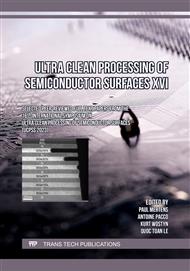[1]
C. Ryu, K.-W. Kwon, A. L. S. Loke, H. Lee, T. Nogami, V. M. Dubin, R. A. Kavari, G. W. Ray, and S. S. Wong, Microstructure and Reliability of Copper Interconnects, IEEE Transactions on Electron Devices 46 (1999) 1113.
DOI: 10.1109/16.766872
Google Scholar
[2]
A. Razavieh, P. Zeitzoff, and E. J. Nowak, Challenges and Limitations of CMOS Scaling for FinFET and Beyond Architectures, IEEE Transactions on Nanotechnology 18 (2019) 999.
DOI: 10.1109/tnano.2019.2942456
Google Scholar
[3]
A. Spessot, B. Parvais, A. Rawat, K. Miyaguchi, P. Weckx, D. Jang, and J. Ryckaert, Device Scaling Roadmap and Its Implications for Logic and Analog Platform, in 2020 IEEE BiCMOS and Compound Semiconductor Integrated Circuits and Technology Symposium (BCICTS) (2020), p.1–8.
DOI: 10.1109/bcicts48439.2020.9392980
Google Scholar
[4]
D. Gall, Metals for Low-Resistivity Interconnects, in 2018 IEEE International Interconnect Technology Conference (IITC) (2018) 157–159.
DOI: 10.1109/iitc.2018.8456810
Google Scholar
[5]
D. Gall, The Search for the Most Conductive Metal for Narrow Interconnect Lines, Journal of Applied Physics 127 (2020) 050901.
DOI: 10.1063/1.5133671
Google Scholar
[6]
D. Tierno, K. Croes, A. Ajaykumar, S. Ramesh, G. Van den Bosch, and M. Rosmeulen, Reliability of Mo as Word Line Metal in 3D NAND, in 2021 IEEE International Reliability Physics Symposium (IRPS) (2021) 1–6.
DOI: 10.1109/irps46558.2021.9405132
Google Scholar
[7]
International Roadmap for Devices and Systems (IRDSTM) 2020 Edition - IEEE IRDSTM, https://irds.ieee.org/editions/2020.
Google Scholar
[8]
A. Pacco, Y. Akanishi, and Q. T. Le, Roughness and Uniformity Control during Wet Etching of Molybdenum, Solid State Phenomena 314 (2021) 295.
DOI: 10.4028/www.scientific.net/ssp.314.295
Google Scholar
[9]
V. A. Petrochenkov, I. G. Gorichev, V. V. Batrakov, A. D. Izotov, and A. M. Kutepov, Catalytic Effect of Ammonia on the Kinetics and Mechanism of MoO3 Dissolution in Alkaline Solutions, Theoretical Foundations of Chemical Engineering 38 (2004) 386.
DOI: 10.1023/b:tfce.0000036965.59052.20
Google Scholar
[10]
A. Pacco, T. Nakano, S. Iwahata, A. Iwasaki, and E. A. Sanchez, Etching of Molybdenum via a Combination of Low-Temperature Ozone Oxidation and Wet-Chemical Oxide Dissolution, Journal of Vacuum Science & Technology A 41 (2023) 032601.
DOI: 10.1116/6.0002404
Google Scholar
[11]
D. S. Fischl and D. W. Hess, Molybdenum Etching with Chlorine Atoms and Molecular Chlorine Plasmas, Journal of Vacuum Science & Technology B: Microelectronics Processing and Phenomena 6 (1988) 1577.
DOI: 10.1116/1.584218
Google Scholar
[12]
Y. Lee, Y. Kim, J. Son, and H. Chae, Low-Temperature Plasma Atomic Layer Etching of Molybdenum via Sequential Oxidation and Chlorination, Journal of Vacuum Science & Technology A 40 (2022) 022602.
DOI: 10.1116/6.0001603
Google Scholar
[13]
G. Van Rossum and F. L. Drake, Python 3 Reference Manual (CreateSpace, 2009).
Google Scholar


